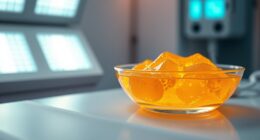The 2024 JAMA meta-analysis confirms that bright-light therapy offers strong, evidence-based benefits for your mental health. It helps realign your circadian rhythms, improving mood, sleep quality, and daytime alertness. This non-invasive, drug-free treatment is especially effective if you have depression, jet lag, or disrupted sleep patterns. By supporting your body’s internal clock, it promotes emotional stability and overall well-being. To understand how this simple intervention could help you, explore the details further.
Key Takeaways
- The 2024 JAMA meta-analysis confirms bright-light therapy significantly improves depressive symptoms, especially in seasonal affective disorder.
- Consistent exposure to bright light realigns circadian rhythms, enhancing sleep quality and daytime alertness.
- The analysis highlights non-invasive, drug-free benefits, making it a preferred alternative for mood disorder treatment.
- Evidence indicates early morning light exposure yields the strongest circadian realignment and mood improvements.
- Long-term use sustains mood stability, with benefits persisting beyond initial sessions.

Evidence-based benefits demonstrate the tangible advantages of applying research-backed practices in various fields. When it comes to bright-light therapy, recent findings from the 2024 JAMA meta-analysis shed light on its profound impact on mental health and overall well-being. If you’re considering this treatment, understanding how it influences circadian alignment and mood improvements can help you make an informed decision. Bright-light therapy works by exposing you to specific wavelengths and intensities of light, which help synchronize your internal clock with the external environment. This process, known as circadian alignment, is essential for regulating sleep-wake cycles and maintaining hormonal balance. When your circadian rhythms are aligned, your body functions more efficiently, leading to better sleep quality, increased alertness during the day, and a more stable mood. The meta-analysis underscores that individuals suffering from seasonal affective disorder (SAD), depression, or sleep disturbances often experience significant benefits, including enhanced mood and energy levels, after consistent light therapy sessions.
You’ll notice that this treatment is especially effective for those whose circadian rhythms are disrupted, such as shift workers or individuals experiencing jet lag. By resetting your internal clock, bright-light therapy helps alleviate symptoms of depression and improve your overall mood. The research shows that mood improvements aren’t just temporary; they tend to sustain over time with continued use, making it a practical option for long-term mental health management. Furthermore, because bright-light therapy is non-invasive and drug-free, it appeals to people seeking alternatives to medication, especially when side effects are a concern. The meta-analysis also points out that early morning exposure yields the best results for circadian realignment, helping you wake up feeling more refreshed and balanced.
In essence, the evidence confirms that aligning your internal clock through controlled light exposure directly influences your emotional state—reducing depressive symptoms and enhancing mood stability. If you’re struggling with mood swings, low energy, or sleep issues, incorporating bright-light therapy into your routine could offer tangible benefits backed by solid scientific evidence. By targeting the root of circadian misalignment, you’re not just addressing symptoms but fostering a more harmonious relationship between your biological rhythms and daily activities. This approach results in a more positive outlook, better sleep quality, and an overall improvement in mental health, making it a compelling, evidence-based option worth considering.
Frequently Asked Questions
How Does Bright-Light Therapy Compare to Medication Treatments?
You’ll find that bright-light therapy differs from medication treatments mainly in mechanism differences; light therapy influences your circadian rhythms, while medications often target neurotransmitters. Many patients prefer light therapy because it’s non-invasive and free from drug side effects. It’s a good option if you want a natural approach or have concerns about medications, and your choice depends on your specific needs and lifestyle.
Are There Any Long-Term Side Effects of Bright-Light Therapy?
Think of bright-light therapy as a gentle tide—generally safe and predictable. Long-term safety remains promising, with minimal side effect profile reported in studies. Most users experience no significant issues over extended periods. However, some might encounter eye strain or sleep disturbances if not used properly. Overall, with proper guidance, bright-light therapy offers a low risk of lasting side effects, making it a safe option for managing mood and circadian rhythm disorders.
Can Bright-Light Therapy Be Effective for Non-Seasonal Depression?
Yes, bright-light therapy can effectively treat non-seasonal depression by aiding circadian regulation and promoting mood stabilization. When you use it consistently, especially in the morning, it helps reset your internal clock, reducing depressive symptoms. This therapy isn’t limited to seasonal affective disorder; it also benefits those with persistent depression, supporting your overall mental health and daily functioning.
What Are the Optimal Duration and Timing for Treatment Sessions?
For effective treatment, you should schedule sessions in the morning to align with your circadian rhythm, usually between 6 to 8 a.m. The ideal session length is about 30 minutes, but this may vary based on individual response. Consistency is key—try to maintain daily treatment, adjusting duration as needed under your healthcare provider’s guidance. Proper treatment scheduling enhances the benefits of bright-light therapy for non-seasonal depression.
Is Bright-Light Therapy Suitable for Children and Adolescents?
You might wonder if bright-light therapy suits children and adolescents; the answer is yes, with caution. Studies show pediatric safety is generally good, and early research suggests minimal developmental impact when supervised properly. Bright-light therapy can effectively treat seasonal affective disorder in young people, but it’s essential to tailor treatments to their age and monitor for any adverse effects. Always consult a healthcare professional before starting therapy for kids.
Conclusion
As you consider the 2024 JAMA meta-analysis, it’s clear bright-light therapy offers tangible benefits backed by solid evidence. Like a modern-day alchemist transforming moods and circadian rhythms, you can harness this simple treatment to improve sleep, mood, and overall well-being. Just remember, even in an age of innovation, sometimes the most effective solutions are as timeless as the wisdom of the ages—proof that science and nature often walk hand in hand.








